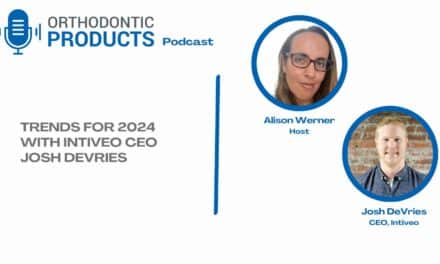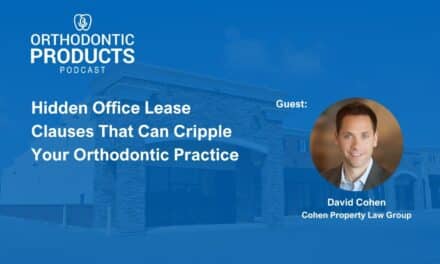Building a cohesive orthodontic team often hinges less on clinical skill than on how well individuals understand—and adapt to—each other’s work styles. That’s why the latest Orthodontic Products Podcast turns the spotlight on the DISC behavioral assessment. Consultant and Everbloom founder Cassie Kellner joins host Alison Werner to explain how identifying Dominance, Influence, Steadiness, and Conscientiousness traits can transform everyday interactions in the clinic.
Kellner outlines the four DISC profiles: decisive D-types who value control and quick results; energetic I-types who rally morale; steady S-types who prefer a calm, collaborative work environment; and meticulous C-types who focus on accuracy and data. Because individuals often reflect a blend of neighboring styles, the assessment generates a personalized behavior profile. In practice, this can help orthodontic teams better understand how colleagues communicate, what motivates them, and how they handle stress. Workshops based on these assessments often prompt team members to reflect on their own preferences and share insights with one another, leading to greater empathy and more effective collaboration.
Beyond self-awareness, the DISC framework can serve as a practical tool for team management. The version Kellner uses—developed by Wiley—includes a digital portal that allows practices to store assessment results and generate comparison reports. These reports help team leaders understand how different personality types interact and offer communication strategies tailored to each pairing. In startup practices, the assessment can help clarify roles and responsibilities among small, multitasking teams. In more established practices, it can be used to address interpersonal dynamics, manage turnover, and support a cohesive culture amid generational or structural changes. Kellner notes that when practices prioritize team connection and communication, operational improvements often follow.
What We Discussed:
-
Understanding the four DISC styles: Kellner explains how Dominance, Influence, Steadiness, and Conscientiousness show up in team behavior, communication, and stress responses.
-
Balancing strengths across the team: Opposing styles—like high-energy I types and detail-focused C types—can work in sync when their differences are acknowledged and supported.
-
Making behavior visible and shareable: DISC gives teams a shared language to express motivators and stressors, helping staff better understand one another without judgment.
-
Identifying quiet contributors: S and C styles may hold back in meetings; DISC workshops help surface their input and foster more inclusive conversations.
-
Using DISC as a leadership tool: With team profiles and comparison reports, practice leaders can tailor communication strategies, reduce friction, and strengthen team cohesion.
Chapters
00:00 Introduction to DISC and Team Dynamics
04:09 Understanding DISC Assessment and Its Categories
09:11 The Benefits of DISC for Teams
13:24 Applying DISC in Startups vs Established Practices
16:36 Building a Thriving Team Culture with DISC
Resources Mentioned:
Guest Contact Information:
Cassie Kellner is the founder of Everbloom, an orthodontic consulting firm focused on team culture, leadership development, and emotional intelligence. With over two decades of experience in orthodontics—from front-line team member to consultant and coach—Cassie helps practices unlock their people potential.
- Website: https://www.discovereverbloom.com
Previous Episodes Featuring Cassie Kellner:
Podcast Transcript
Alison Werner (00:04)
Hello and welcome to the Orthodontic Products podcast. I’m your host, Alison Warner. On this episode, we’re going to talk about DISC, a behavior assessment tool and how it can help you create a more cohesive team. And to do that, Cassie Kellner is back with me. Cassie is the founder and owner of Everbloom, an orthodontic consulting firm. She has over two decades of experience in the orthodontic field, starting as a team member before turning to consulting, lecturing, and working as a practice coach. Cassie, thanks for joining me again.
Cassie Kellner (00:32)
Thank you for having me.
Alison Werner (00:34)
All right, so we’re gonna talk about disc. Let’s just start at the beginning. What is disc?
Cassie Kellner (00:37)
Yes. Okay.
By the way, have you ever taken an assessment? don’t know that I’ve asked you this.
Alison Werner (00:44)
A disc assessment? No, but I’ve done like Myers -Briggs and that kind of stuff. Okay, all right.
Cassie Kellner (00:47)
Okay, yeah, yes, yes.
Okay, so it’s very similar. So DISC is a behavior assessment and there are four things that you can really navigate through here, right? So you have dominance, which is D, you have I for influence, you have S for steadiness and C for conscientiousness. So D is for dominance, these people are like super,
Alison Werner (00:52)
Okay.
Mm -hmm.
Cassie Kellner (01:16)
They are dominant in things that they do, right? So they like to be in control. There’s some power there. They like to get immediate results. There’s no fluff. And then you have I for influence. So I is super social. They’re almost like the cheerleader of the team. They like to like, yeah, guys, let’s do this. We can, they’re super high energy.
Alison Werner (01:37)
Mm
Mm -hmm.
Cassie Kellner (01:43)
And then you have steadiness. Steadiness likes to keep things very cohesive. They do not like to be in chaotic environments. They like the team to get along. They don’t like toxic cultures. They’re almost like the team therapist. They fall into this role a lot. And then you have C, which is conscientiousness. So conscientiousness, C team members are
Alison Werner (01:48)
Okay.
Mm.
Mm -hmm.
Okay.
Cassie Kellner (02:11)
they make sure that things are incredibly accurate. Like they’re super detail oriented. They really focus on data. They don’t love being wrong because they focus so much on data that they are super accurate. Like they’re very meticulous in what they do. So it is actually.
Alison Werner (02:24)
Okay.
Mmm.
Cassie Kellner (02:37)
not very common for them to be wrong because they’re so such detailed oriented people. So that’s kind of like a very short easy breakdown of all of the behaviors when it comes to this.
Alison Werner (02:39)
you
Yeah.
Okay, and then you take this behavior assessment, you find out if you’re a D an I an S, a C could you be two things? Okay.
Cassie Kellner (02:58)
you can be two things. So
depending on where you land on the disc wheel, you can fall in different categories. I would get, this is like going to get confusing, so I won’t go too deep. But you also have like shading, right? Your shading is everything. So if anybody’s ever seen, you know, a disc wheel, you can see that shading lands somewhere. So me personally, I am a high I.
Alison Werner (03:03)
Mm -hmm.
Yeah, that’s
Mm
Cassie Kellner (03:23)
So my shading, like I live in the I. I’m super enthusiastic. I love working in group settings, know, things like that. But if somebody also were to be an I, but also have a dominant personality, they could be an ID, right? So you can be multiple. They have to be neighbors. They have to be neighbors. So you could be like an IS.
Alison Werner (03:26)
Okay.
Okay.
Okay. Mm -hmm. Mm -hmm.
Cassie Kellner (03:50)
or an SI, you can be an SC. So they have to be neighbors within the wheel. But yes, you can be multiple. And then if we went even further, you could have shading that would maybe land somewhere else where maybe you are, it’s easy for you to live in that behavior, essentially.
Alison Werner (03:51)
Mm -hmm.
Okay.
Okay,
okay, and so you take this assessment, find out where you land, how are you then using that?
Cassie Kellner (04:18)
So I use this in orthodontic practices and I can tell you my story on why I started using this. Great. Okay, all right. So in 2020, we all know 2020, we remember 2020. In 2020, I was a consultant and I realized that I was a consultant slash therapist.
Alison Werner (04:24)
Yeah, was gonna ask you, yeah, why did you decide to become a disc coach? I guess let’s go there first. Okay.
Yep.
Cassie Kellner (04:43)
You know, I was constantly checking in with people. People were reaching out to me because they were struggling with X, Y, and Z. And we had very limited connection that year, right? And people were struggling to connect. We also had generational divides. Things were happening in the world that people were really struggling to connect. People were struggling to connect with their own team members.
Alison Werner (04:55)
Mm -hmm.
Yeah. Yeah.
Cassie Kellner (05:11)
And so I realized that I was playing this role of consultant, which I love and I know, but I was also playing this role of therapist and I have no degree in therapy whatsoever. I mean, just, people, people are my thing, right? And so I was like, okay, I have to do something more. I have to be able to understand individuals. I want to know the why behind their behaviors and what they’re doing as opposed to giving advice or helping team members when I don’t really have.
Alison Werner (05:16)
Mm -hmm. Yeah.
Mm -hmm. Yeah.
Cassie Kellner (05:39)
enough information about what’s really going on. Fast forward, I did a crazy amount of research and I landed on DISC. I thought it was the easiest tool for practices and really anyone to understand themselves and their team members. So I became a DISC coach. And so now it’s been, you know, just over four years because it was early in 2020. And
Alison Werner (05:42)
Mm -hmm.
Okay.
Mm -hmm. Mm -hmm.
Okay.
Mm
Cassie Kellner (06:09)
It’s been amazing to watch these team members evolve and connect while using this tool.
Alison Werner (06:20)
Okay, so can you share an experience of working with an orthodontic team and bringing disc in and how that goes and what it can accomplish?
Cassie Kellner (06:31)
Yeah, absolutely. I mean, there’s many different things that you can get from it. One, it’s just, the first and foremost, it’s just a lot of fun. Like being able to sit around with your team and discuss who you are, it is so much easier as an adult and an adult in the workplace environment to have it written out in black and white and for me to go, yep, this is exactly who I am and this is why.
Alison Werner (06:39)
Mm
Mm.
-huh.
Yeah.
Cassie Kellner (07:00)
I am the way that I am. And for people across from you to go, this makes so much sense. And you go, yes, this does make so much sense, right? In the workshop, there’s a lot of self -reflection. There’s a lot of sharing. People share. There’s exercises that we do. And a lot of it is like, okay, so I want you to read through.
Alison Werner (07:02)
Mm -hmm.
Ha!
Yeah.
Cassie Kellner (07:26)
This is a perfect example. There’s a page of motivators and stressors. What motivates you? What stresses you out based on your behavior, right? So I’m like, okay, I want you to highlight three statements that you want to announce to your team. This is an exercise I was doing for practice. The orthodontist, she starts hysterically laughing and I’m like, what? And everyone’s quiet because they’re doing the exercise. And she goes, I really just want to color the entire page. I can’t believe.
Alison Werner (07:35)
Mm -hmm.
Cassie Kellner (07:55)
This is me in black and white. And that’s not the case for everyone. I would say, in my experience, 98 % of people that are taking these assessments are so blown away at how correct it is because they’re the ones taking the assessment. And there’s no right or wrong answer. And there’s no personality or behavior that is better than the other. Quite honestly.
Alison Werner (07:56)
You
Yeah.
So, yeah.
Mm
Cassie Kellner (08:21)
You want your team to land in all four of these categories because then you have a really well -rounded team. You know, I had a colleague for years that was, I was the I and she was a C. And we worked so well together, but we were so incredibly opposite, but my strengths were her weaknesses and her weaknesses were my strengths. So you want everyone to land everywhere on this wheel. But you know,
Alison Werner (08:27)
Mm, okay.
Mm.
⁓ okay.
Mm
Cassie Kellner (08:51)
Being able to connect, reading this in black and white, being able to say these things out loud, like, yeah, this actually does stress me out. I don’t like when this happens. It really just almost gives team members a voice to say, this is who I am, and now you get me on a deeper level.
Alison Werner (09:01)
Yeah.
How does an orthodontic team know if they could benefit from working with DISC?
Cassie Kellner (09:18)
Honestly, I would say any team, any orthodontic or not, would benefit from doing DISC. It doesn’t matter if you’re a new team, a small team, a team who has worked together for 15 to 20 years, a large team, you name it, everyone in my opinion should do this. Because I’ve worked with teams who know each other so well they’re almost like a family.
Alison Werner (09:33)
Mm
Mm
Mm -hmm.
Cassie Kellner (09:44)
And
so going into it, they’re like, yeah, I knew this, but they didn’t know why. It also gives them an opportunity to speak up, right? There are plenty of team members you know that sit in meetings and they’re the last to speak up. You’ll find that people who land in the I category, they’re always the first to speak up. They wanna share first. And people who fall in the C or S category, they’ll let everyone else go before they have to speak up, right?
Alison Werner (09:49)
Hmm.
Okay.
Yeah.
Mm. Mm -hmm.
Yeah.
Cassie Kellner (10:12)
there’s there’s an understanding of like why why do you do this or i people there are plenty of people out there that do not like social recognition they don’t want you to announce what a good job they did they they want you can tell them but they don’t need you to broadcast this to the entire team and then there are team members who are like this is my love language please announce that i’ve done all of these things because it
Alison Werner (10:17)
Mm -hmm.
Mm -hmm.
Mm -hmm.
Yeah. Yeah.
Cassie Kellner (10:40)
makes me feel good, it helps me thrive in this practice. you know, again, I think it should be everyone. I think it’s also incredibly, really, it does such an amazing job at culture building. So, you know, people understand each other and they can connect for more. In one of the exercises that I do, we do comparison reports. This is really fun. So it’s like a breakout session.
Alison Werner (10:55)
Mm.
Okay.
Cassie Kellner (11:08)
and I pair individuals who either have styles that are alike or completely opposite, or if there’s some tension happening, then we’ll do a comparison report and we’ll find out why. And so, you know, it’s just a really great tool to get to know your team.
Alison Werner (11:17)
Mm
Okay.
Mm -hmm. Okay. So it really sounds like it can help with those dynamics between two employees or the culture as a whole.
Cassie Kellner (11:38)
Absolutely, absolutely. Now, there’s a million DISC assessments that you can take out there. mean, if you Google this, everything’s gonna pop up for you. I use a very specific DISC assessment. So it’s through Wiley. And so essentially what you get with it as a practice is they get to have a login forever. So not only do you get the assessment, the workshop,
Alison Werner (11:47)
Mm
Okay.
Mm
Okay.
Cassie Kellner (12:06)
but they also get in a portal where they can log in and they can see everyone on their team
at any given moment. let’s say, let’s say Alison, that you
Alison Werner (12:17)
WUF WUF
Cassie Kellner (12:18)
I, let’s say that you and I worked together, right? And we really wanted to understand each other and maybe there was some tension or maybe I was starting a project or an initiative and I wanted your buy -in on it. I could simply just click on your name and it would
in your behavior and it’s going to do a comparison right there of how you get Alison to buy in on things that you want. If there’s tension between Cassie and Alison, how do you go about this based on their behavior and where they landed on this wheel? So not only do you get workshops and assessments, but you also get to use this going forward. Anyone can, but really your leadership team can use this as a tool.
to make sure that you guys are, that any team is constantly connecting.
Alison Werner (13:10)
can you talk a little bit about how this can work for a
practice and then how it benefits an established practice? Because I’m imagining there’s a
know, some benefits or a different vibe for each of those.
Cassie Kellner (13:25)
my gosh, absolutely. So a startup, obviously you have a much smaller team, but if you are a startup, your team members are likely doing multiple different roles, right? So you may have, you know, your scheduling coordinator may be also doing a TC role or maybe they’re doing some financials. You may have a clinical team member that’s running in a million different directions. So just because you’re small does not mean you’re not mighty.
Alison Werner (13:36)
True.
Cassie Kellner (13:52)
and they should be able to connect on a deeper level. just like I talked about understanding motivators and stressors for startup practice, like really getting to the bottom of who these individuals are, I think is incredibly important. Now to go to the experience side, typically if you’re an experienced practice, you have more team members, there may be turnover.
There’s so many interpersonal dynamics if you’re a very large team, even if you’re a team member of five, team member of 10, team member of 50, to understand each other’s behaviors, I think in my opinion in the workplace is absolutely crucial so that you know what they can handle, what they can’t handle, what they like, what they don’t like, what motivates them, what stresses them out.
how they collaborate with other individuals. And it also just truly this assessment, whether you’re a startup or experienced or you have a very large practice or a small practice, it allows your team to have a safe space to go, yes, this is who I am. This is what I love. This is what really stresses me out.
Alison Werner (15:14)
Yeah.
Cassie Kellner (15:14)
It
gives them strategies to be able to work with other individuals who are not like them.
Alison Werner (15:21)
Well, that’s and you just mentioned that it gives you strategies for how to work with people who aren’t like you. So it does take it a step further beyond just telling you who you are or helping your teammates identify who you are. There are strategies, I guess, that come with understanding what your assessment or your type is. Yeah.
Cassie Kellner (15:32)
yes.
Absolutely.
Yeah, absolutely. it breaks it down for you, right? If I’m an I and I’m really struggling with working with a D personality, it’s going to give me strategies on exactly how to go about this, how to approach them, what they like, what they don’t like, so that I can really work with these individuals. So as leaders, to be able to understand your team on a deeper level, I mean, in my opinion, it’s…
Alison Werner (15:59)
Mm.
Cassie Kellner (16:12)
It’s probably one of the best things that you can do.
Alison Werner (16:15)
Yeah, yeah. Well, it all sounds like to tie this together to some of our previous episodes, like we talked about building a thriving culture and, you know, working with your onboarding. It’s all aimed at building that team cohesiveness, that team culture, building a team, you know, so you’re not just individuals working in an office.
Cassie Kellner (16:33)
Absolutely.
Yeah, I mean, that’s my mission too, Alison. I’ve been doing this a really long time and truly the reason why I do what I do now and the creation of Everbloom is that individuals are allowed to continue to bloom. My mission is, well, yes, I think systems.
Alison Werner (16:55)
Mm.
Cassie Kellner (17:02)
and financials and technology. think all of those things are really important for thriving practice. I think if you start with your humans, your team, your individuals first, and all of the things that I believe in, that we do at Everbloom, then you can work on your bottom line. You can work on production. You can work on all these things if you have a thriving, loving team.
Alison Werner (17:07)
Mm -hmm. Yeah.
Mm -hmm.
Yeah.
Great. Well, Cassie, if anyone is interested in working with you, where can they find out more?
Cassie Kellner (17:38)
They can go to discovereverbloom .com and for this in particular, they can go to culture building workshops. We have many different workshops. You could do a one workshop with your entire team. We also have a six month culture building program for your entire team. And we also have a leadership program where we work with leaders and that we tap into emotional intelligence, leading. It’s a really fun, fun workshop that we do too.
Alison Werner (17:42)
Mm
Hmm. Okay.
⁓ great. Cassie, always a pleasure to have you on and we’ll talk to you again soon. So thank you very much.
Cassie Kellner (18:11)
Thanks, Alison.













